Anacardium, Marking NutMarking NutBhallataka (Ayurveda) Bhilava, Baladur, Kaaju (Unani) Sorankotai (Siddha) Go bye གོ་བྱེ (Tibetan) |

|
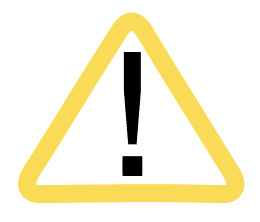
|
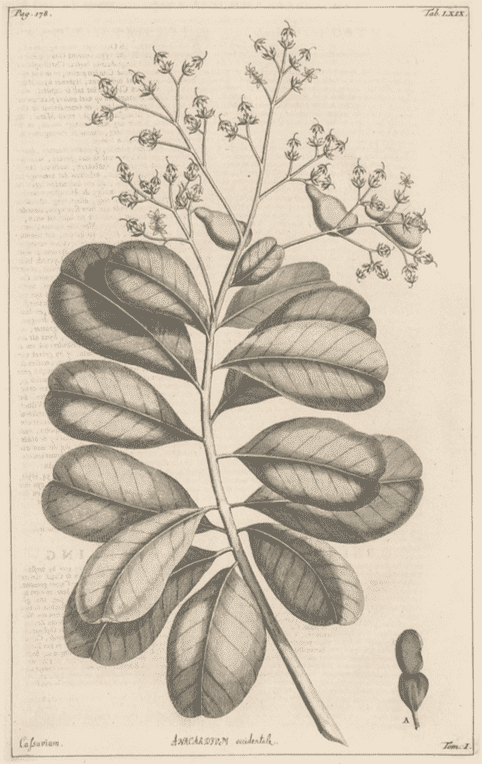 Herbarium Amboinense, Rumpf, 1755
Herbarium Amboinense, Rumpf, 1755
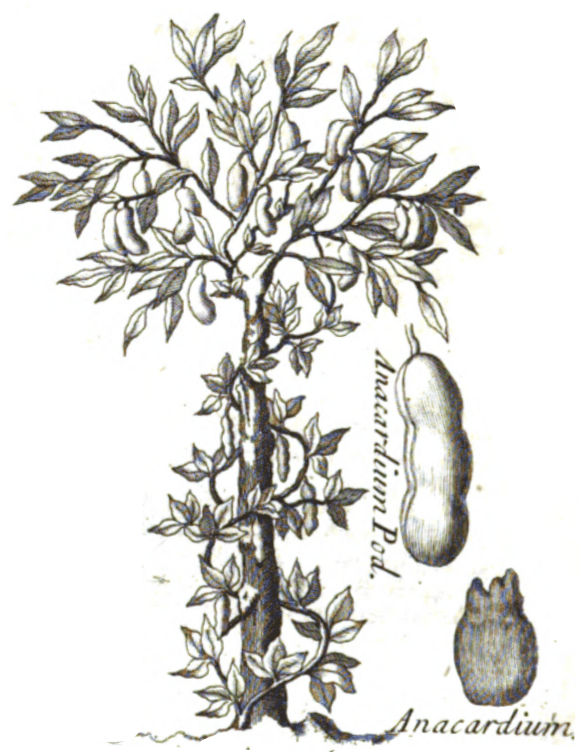
|
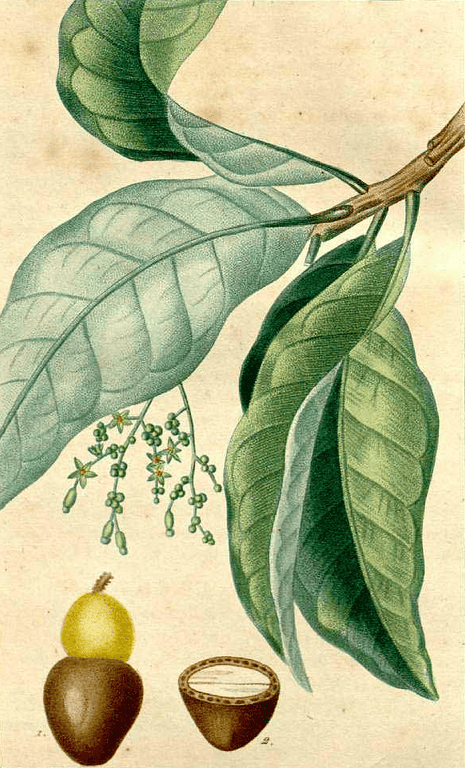
|
|
A Complete History of Drugs, Pomet, London, 1748 |
Descourtilz, Flore médicale des Antilles, 1822 |
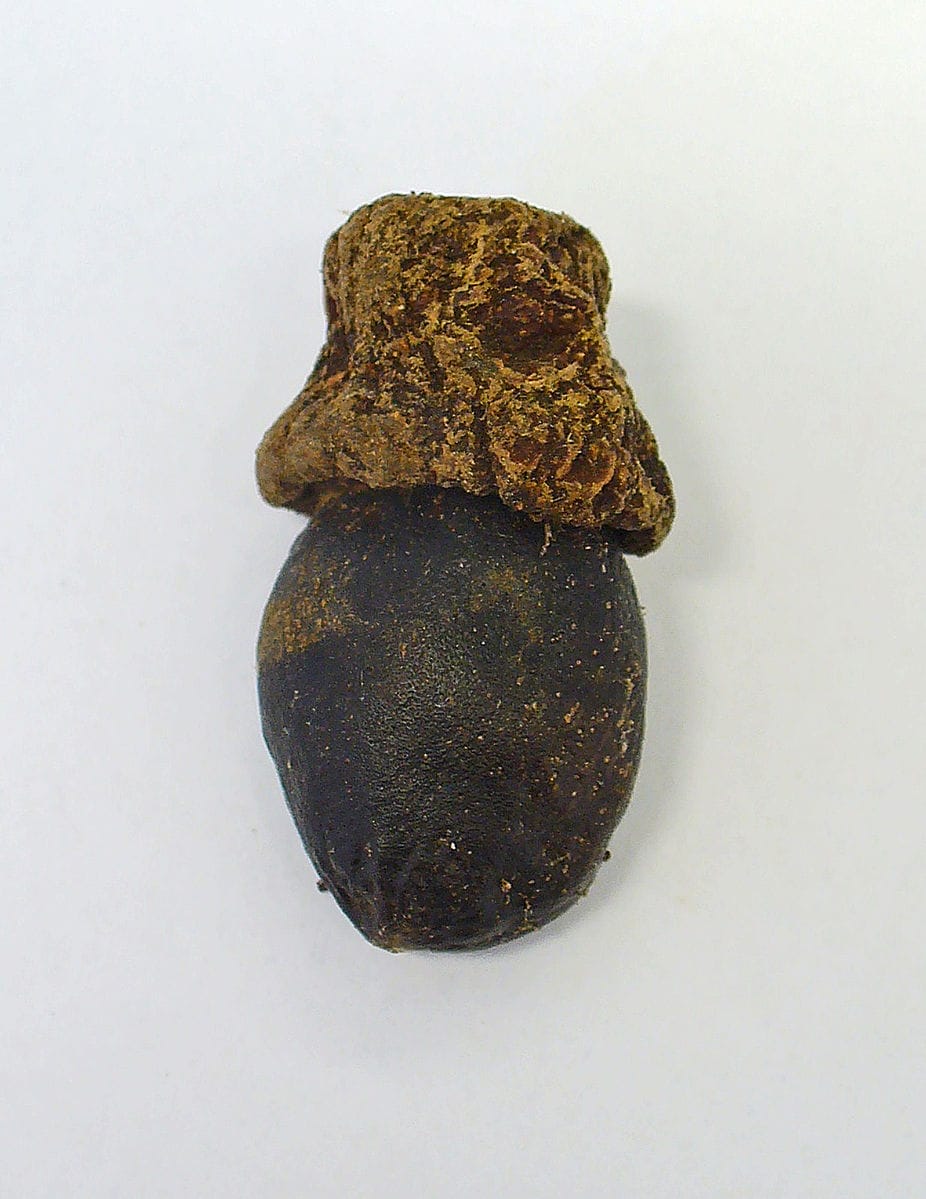 Dried Semecarpus anacardium
Dried Semecarpus anacardium(Photo by H. Zell) (Wikimedia)
Botanical name:
Semecarpus anacardium
Parts used:
Detoxified Fruit; resinous juice contained in the seeds; oil
Temperature & Taste:
Hot, dry. Sweet. Toxic
“It is Hot and Dry in the last stage of the Fourth degree”. (Avicenna)
Uses:
1. Warms and Strengthens the Kidneys:
-Sexual Debility; Impotence
-Aphrodisiac
-increases amount of Semen
-Premature Aging; removes Wrinkles, Grey Hair, Loss of Hair (Unani)
2. Clears Damp, Strengthens the Brain and Nerves:
-Cold and Damp diseases of the Brain and Nerves
-‘great specifics in strengthening the Animal Spirits and Faculties’. (Salmon, Seplasium, 1693)
-Strengthens Memory and the Senses; used for mental derangement (West, Ayurveda)
-Hemiplegia, Paralysis, Facial Paralysis (Avicenna)
-Palpitation
3. Clears Damp, Resolves Masses:
-Lymphatic Swellings
-Tumors, Cancers
-Rheumatoid Arthritis
4. Kills Worms
-used for Worms
5. Externally:
-juice of the pericarp and the Oil are both escharotics
-removes Warts, Leukoderma (Avicenna)
-cures Phlegmatic Alopecia (Avicenna)
-eliminates Tattoos (Avicenna)
Dose:
1. Always begin with smaller doses, increasing as needed.
2. While using, avoid heating foods and spices, and anything that aggravates Pitta (Bile).
3. Usually decocted in Milk (in Ayurveda) for Asthma, Neuralgia, Sciatica, Gout, Hemiplegia, Epilepsy
Of the detoxified Nut: 250mg–6 grams daily (generally 1–2 grams). Four nuts decocted in milk were recommended as an Aphrodisiac (Ashtanga Sangraha)
Correctives:
1. Coconut; Sesame seed (Unani)
2. Walnut oil reduces its toxicity (Avicenna). Some recommend taking it with Walnuts.
3. Ghee; Almond oil
4. Barley
Substitute:
1. Balsam Oil
2. This formulation substitutes it: Hazel nut (4 times its weight), Balsam Oil (one-quarter of its weight), White Bitumen (three-quarters of its weight) (Avicenna)
Preparation:
It is generally prepared for internal use (in India).
1. Boiled in Water, then Milk, Ghee, and mixed with Jaggery. Prepared like this it is said to be the King of Rasayanas (tonic medicines) in India.
2. It was traditionally boiled with Cow dung, then boiled in water to detoxify.
–Śodhana: An Ayurvedic process for detoxification and modification of therapeutic activities of poisonous medicinal plants
Main Combinations:
1. Worms:
i. Anacardium with Embelia ribes for Guinea Worm.
2. Arthritic pain:
i. Anacardium with Bdellium
ii. Anacardium with Turmeric, Frankincense, Emblic Myrobalan
3. Chronic Skin diseases:
i. Anacardium with Madder, Turmeric, Psoralea
ii. Anacardium with Sesame seed, Chebulic Myrobalan, Jaggery (equal parts)
iii. Anacardium with Tinospora, Margosa bark, Embelia, Costus, Plumbago, Picrorrhiza, Calamus, Madder, Bdellium
4. Hemorrhoids, Anacardium with Ginger, Chebulic Myrobalan, Holarrhena antidysenterica, Plumbago
5. Rejuvenation:
i. Anacardium with Emblic Myrobalan, Chebulic Myrobalan, Long Pepper
ii. Anacardium with Triphala, Plumbago, Embelia, Eclipta, Iron Bhasma, mixed with Ghee and Sugar
6. Syphilis, Anacardium with Sesame seed, Chebulic Myrobalan, Jaggery (equal parts)
7. As a topically anti-inflammatory, boil the nuts in castor oil
Major Formulas
Powder to Strengthen the Memory
Diacameron Minus (Nicholas)
Diacameron Magna (Diathamaron) (Nicholas)
Punarnavadi Guggulu (Boerhaavia and Bdellium Pills)
Cautions:
1. Toxic in overdose. Even touching it causes itching and swelling.
2. Avoid in Heat (Bile) conditions
3. Not used in the very young, very old, or during Pregnancy.
4. Overuse or large doses damages Yin and causes Black or Burnt Bile.
‘Its honey-like matter causes ulcers and inflammation and burns up blood and humours’. (Avicenna)
‘It disturbs the thinking power and stirs melancholia’. (Avicenna)
Antidote:
1. ‘Churned Milk is its antidote’. (Avicenna)
Main Preparations used:
Confection, Honey and occasionally an expressed Oil were used.
|
‘The marking-nut, in Sanskrit Bhallataka and Arushkara, is regarded by the Hindus as acrid, heating, stimulant, digestive, nervine and escharotic, and is used in dyspepsia, piles, skin diseases, and nervous debility. It is prepared for internal use by being boiled with cowdung and afterwards washed with cold water. The nut is also used to produce the appearance of a bruise in support of criminal charges preferred through enmity, and the juice is sometimes applied to the body out of revenge, the victim having first been made insensible by the administration of narcotics. In Sanskrit medicinal works a section is often devoted to the treatment of ulcerations thus produced. When given internally the juice of the pericarp is always mixed with oil or melted butter. Tho Arabic name for the nut is Hab-el-Kalb, an allusion to its heart-shaped form. Mahometan writers order the juice to be always mixed with oil, butter, or some oily seed when used for internal administration. They consider it to be hot and dry, useful in all kinds of skin diseases, palsy, epilepsy, and other affections of the nervous system, the dose being from 1/4 to 1/2 a dirhem. Externally they apply it to cold swellings, such as piles; the Tuhfat notices the use of the vapour of the burning pericarp for this purpose, a practice which I have noticed in Bombay; it causes sloughing of the tumours. When too large a quantity has been taken, oily and mucilaginous remedies should be prescribed. Two dirhems is considered a poisonous dose. Some persons are much more readily affected by the drug than others. Garcia d’Orta remarks that the poisonous properties of the marking-nut have been much exaggerated by Serapion, and goes on to say that in Goa it is administered internally in asthma after having been steeped in buttermilk, and is also given as a vermifuge; and moreover says he, we (the Portuguese) salt the young green fruit and use them like olives. Ainslie gives the following account of its use in Southern India. The Hindus give the juice in scrofulous, venereal |
and leprous affections in very small doses; an oil is also prepared with the nut by boiling, which is used externally in rheumatism and sprains, it is of a very stimulating nature; undiluted it acts as a blister. The Telingoos have the following prescription:— Juice of marking-nut and garlic of each 1 ounce, juice of fresh tamarind leaves, cocoanut oil and sugar of each 2 ounces; mix, and boil for a few minutes. Dose— One table spoonful twice daily in syphilis, aches, sprains, &c. Mixed with a little quicklime and water the juice is used all over India for marking linen, and is far more durable than the marking inks of Europe. In tho Concan a single fruit is heated in the flame of a lamp and the oil allowed to drop into a quarter seer of milk; this draught is given daily in cough caused by relaxation of the uvula and palate. As an application to scrofulous glands of the neck equal parts of the juice of Bibba, Plumbago zeylanica (Chitrak), Baliospermum montanum (Danti-mul), Euphorbia nereifolia (Newarang), Asclepias gigantia (Rui ruandar), sulphate of iron, and molasses are used. The juice of the root-bark is also used medicinally on account of its acrid properties. The brown oil of the marking-nut appears to resemble very closely in its medical action that of the cashew-nut. Basiner found that within 12 hours it raised a black blister; this should be carefully protected from touch, as the fluid causes eczematous vesicles on any part of the body it may come in contact with. Basiner has also noticed painful micturition, the urine being reddish brown and bloody, and painful stools as a sequel to the external application of the oil. (Am. Journ. Pharm., Mar. 1882, p. 131.) Like the oil of the cashew-nut, this oil appears to have a much less injurious effect than would be expected, when administered internally’. (Vegetable Materia Medica of Western India, Dymock, 1885) |
2. Potent Ethanomedicinal Plant Semecarpus anacardium Linn: A Review.
3. A potential ethnomedicinal plant Semecarpus anacardium Linn. A review
4. Anacardoside from the seeds of Semecarpus anacardium
5. Isolation and characterization of an anticancer catechol compound from Semecarpus anacardium
6. Studies on the mechanism of action of Semecarpus anacardium in rheumatoid arthritis
7. Anti tumour and pharmacological effects of the oil from Semecarpus anacardium Linn. f
